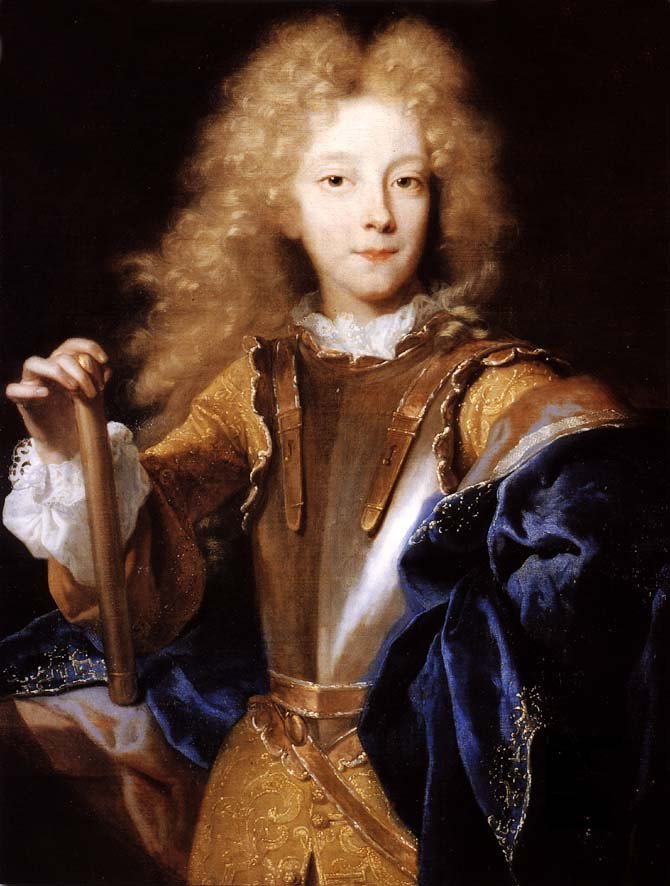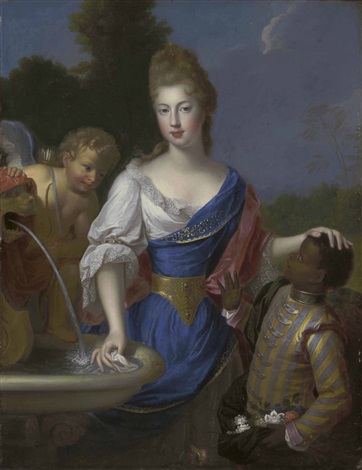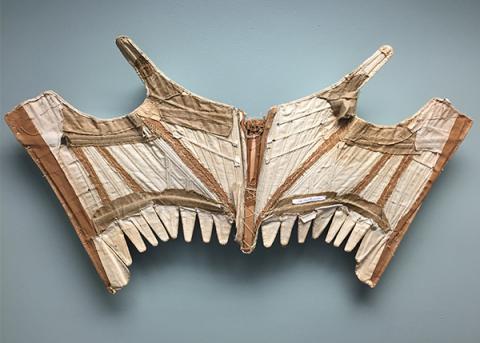Originating in the 9th century, this family had its roots in Artois. Over the years, the family split into six separate branches of which one had become extinct by the ascension of Louis XIV to the French throne. This left a total of five branches of which two would later merge.
However, it can be argued that there were as many as 18 branches as the family grew - this post focuses on these four primary families.
The Duc de Lesdiguières
The title had originally been created for François de Bonne de Lesdiguières whose only legitimate child was the daughter Madeleine. She married Charles de Blanchefort de Créquy, thus bringing the duchy into the Créquy-family after her father's death. Charles died just around the ascension of Louis XIV.
1) François de Bonne de Créquy & (1) Catherine de Bonne, (2) Anne de la Magdeleine
François reached the rank of Marechal de camp and commanded the regiment of French Guards. He inherited most of his possessions through his mother which is why he added her surname - de Bonne - to his own.
François' first wife, Catherine, happened to be his aunt. The couple had no children which prompted Charles to remarry after her death.
Anne was marquise de Ragny in her own right. She was quite the desirable connection; as the only-child, she would inevitably bring her marquisate - with its considerable estate - into her husband's family. She was also the granddaughter of the Duc de Retz.
The couple had two children.
- François Emmanuel, Duc de Lesdiguières
- Charles-Nicolas, Marquis de Ragny
 |
| François |
2) François Emmanuel de Créquy de Bonne & Paule Marguerite Françoise de Gondi
Besides his inevitable military career, François was an avid collector of art. He inherited the governorship of Dauphiné from his father alongside his ducal title.
Paule Marguerite Françoise was an impressive match. As the sole heiress of the Duc de Retz, she became the Duchesse de Retz in her own name as well as the marquise de La Garnache, Comtesse de Joigny and Baronne de Mortagne. Despite such an illustrious portfolio the choice of a Retz-bride was a risky one. The Cardinal de Retz had opposed Louis XIV during the Fronde which placed the entire family in bad standing at the French court.
The couple had one child:
- Jean François Paul, Duc de Lesdiguières
 |
| Paule Marguerite Françoise |
3) Jean François Paul de Créquy de Bonne & Louise Bernadine de Durfort
Serving as a brigadier in the king's army, Jean died unexpectedly young at just 25. His death followed severe injuries sustained in battle. The couple had no children; oddly enough, Louise did not remarry despite being just 23 years old when she became a widow.
 |
| Jean François Paul |
 |
| Louise Bernardine |
4) Alphonse de Créquy & Gabrielle Victoire de Rochechouart
Alphonse was a cousin to Jean François Paul. He was also the head of the fifth branch - that of the Comte de Canaples; he would later inherit his younger brother's possessions, too. He was a close friend of the English Charles II and thus had close ties to the English court. This connection was rather a fall-back as it was the result of a failed career at the French court. Lacking the talents of his brothers, Alphonse tried his luck across the Channel where he proved far more successful.
Gabrielle was the niece of Madame de Montespan and thus a member of the influential Mortemart-family. She outlived her husband by 29 years.
The couple had no children which resulted in the extinction of the title in 1711.
The Prince de Poix
Antoine de Créquy had held the title for years but as a Catholic clergyman, he had no legitimate children. Upon his death, he left the title to his nephew, Antoine de Blanchefort, on the condition that he took up the name of Créquy again. He was a Créquy through his mother, Marie de Créquy. From thence, the family became known as the Blanchefort de Créquy. By the reign of Louis XIV, they were headed by:
1) Charles III de Blanchefort de Créquy & Anne de Beauvoir du Roure
Charles III never actually assumed the title as he predeceased his father, Charles II. Anne, on the other hand, lived a staggering 58 years longer.
The two had had three children:
- Charles, Prince de Poix and Duc de Créquy
- Alphonse, Comte de Canaples
- François, Marquis de Marines
2) Charles IV de Blanchefort de Créquy & Anne-Armande de Saint-Gelais
Charles IV was elevated to the title of Duc de Créquy by Louis XIV who also made him governor of Paris. The couple enjoyed immense royal favour and even hosted the English royal family-in-exile at their private estates. Charles' good fortune stemmed from his loyalty to the crown during the Fronde where he had placed himself at the disposal of Anne of Austria and Louis XIV - the latter ensured his further elevation at court.
Anne-Armande held the position of dame d'honneur to queen Marie-Thérèse which placed her in a position of immense influence at court. She held an enviable reputation at court; considered beautiful, pious and respectful, Anne-Armande and Charles seemingly had a good relationship. When he died in 1687, she permanently retired from court.
The could had just one child:
- Marguerite, Duchesse de Thouars
The title went to the La Trémoille-family after the heiress, Marguerite de Blanchefort de Créquy, married the Duc de Thouars.
The Comte de Créquy-Bernieulles
Probably the shortest-lived branch of the five, this one counted just a single occupant:
1) Alexandre de Créquy & Marie Maignard
Alexandre was the eldest of seven children of which only one had children - and that was not Alexandre but his sister, Renée, who had married Gabriel de Mailloc. Alexandre had inherited all the titles of his father which included the counties of Créquy-Bernieulles and Cléry as well as the barony of Combon.
Marie Maignard was a member of the noblesse de robe as her father was the President of the Parliament in Normandy. The couple had no children, so the title went to Renée's son: Gabriel-René de Mailloc. This also meant that it officially exited the Créquy-family, as Gabriel-René went by his father's name.
The Marquis de Créquy
1) Philippe de Créquy & Louise de Vieuxpont
Philippe could be classed as a member of the lower nobility by the rank of his titles; he was a seigneur of seven different locations as well as baron of Bainquetun. However, this left him very little leverage when it came to advancement.
Louise came with a connection to the Beauffremont-family as well as being the daughter of the seigneur of three different places. The couple married in 1624 and had three children:
2) Jean II de Créquy & Madeleine Le Fèvre de Caumatin
Jean inherited the titles and land when his elder brother, Philippe, died without an heir. He followed his father's footsteps into the army where he was made maréchal de camp in 1651.
Madeleine was the daughter of a state councillor who had also served as ambassador to Switzerland. The couple had seven children:
- Henri-Jacques, Marquis de Créquy
- Jean-François
- Louis
- Madeleine
- Unknown female
- Henri Alexandre, Marquis d'Hemont
- Antoinette, abbess
3) Henri-Jacques de Créquy & (1) Marie-Marthe de Manneville, (2) Marie-Antoinette de Musnière
Henri-Jacques elevated the family considerably from the somewhat obscurity of being seigneurs to being marquises. This opened a whole new playing-field for the family, including possibilities for further advancements.
Marie-Marthe was dame de Baroménil in her own right. She gave her husband four children:
- Unknown male
- Henri-Charles
- Madeleine
- Marie-Catherine, dame de Baroménil
Marie-Antoinette was the baronne d'Espinefort - she seemingly had one child:
- Jacques-Charles, Marquis de Créquy
4) Jacques-Charles de Créquy & Marie-Louise d'Auxy
The family continued to rise during this generation, as Jacques-Charles added the title of Comte de Gensay as well as the baronies of Benin (like the country) and Vineville. Jacques-Charles was a particularly successful soldier - he steadily rose through the ranks until he became a Lieutenant General. He was also made governor of Dommes and served as the Duc d'Orléans' chamberlain.
Marie-Louise was in the service of the Princesse de Conti as her dame d'honneur.
The couple had two children:
- Marie, Comtesse d'Aubry
- Anne Madeleine Françoise, Comtesse de Mesmes
As their daughters were unable to inherit the family's growing number of titles, these went to Charles-Henri de Créquy, the descendant of Henri Alexandre, Marquis d'Hemont. This had the advantage of keeping the title within the family.











